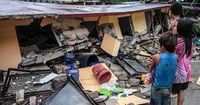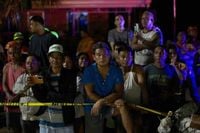In the early hours of October 13, 2025, as most of northern Cebu province slept, the ground trembled once again—reminding residents that the earth’s restlessness is an ever-present companion in the Philippines. At precisely 1:06 a.m., a magnitude-5.8 earthquake jolted communities still reeling from the devastation wrought by a much stronger magnitude-6.9 quake just two weeks prior, on September 30. The Philippine Institute of Volcanology and Seismology (Phivolcs) confirmed that this latest tremor was an aftershock, its epicenter located about 11 kilometers southwest of Bogo City, at a shallow depth of five kilometers.
The impact was immediate and palpable. According to Manila Bulletin, at least 14 people sustained injuries from the aftershock. Eight of these were in Bogo City itself—three suffered chest pains, three had lacerations, one experienced an asthma attack, and another reported minor injuries. In San Remigio, two residents were hurt, while four more in Daanbantayan also sustained minor injuries. The quake also caused a house in Santa Fe to collapse after it was struck by a water tanker, and new structural damage was discovered at Hagnaya Port in San Remigio. Local response teams, acting swiftly, were dispatched to treat victims and assess the growing list of damaged buildings and infrastructure. The Cebu Provincial Disaster Risk Reduction and Management Office (PDRRMO) reported that ongoing assessments were critical to ensure the safety of residents and the integrity of essential facilities.
The aftershock struck at a time of heightened vulnerability. Northern Cebu has been under a state of calamity since late September, formalized through Executive Order No. 57 and Provincial Board Resolution No. 1985-2025. The series of tremors has complicated recovery efforts, stretching local resources and testing the resilience of communities already grappling with loss and uncertainty. As the PDRRMO chief Dennis Francis Pastor explained, continuous assessments are underway, and residents have been advised to remain vigilant for potential landslides, further aftershocks, or additional structural collapses.
But are these relentless earthquakes out of the ordinary? According to Department of Science and Technology (DOST) Secretary Renato Solidum Jr., the answer is a resounding no. Speaking at the Bagong Pilipinas Ngayon briefing, Solidum sought to reassure the public, stating, "That’s normal because of active faults and trenches." He emphasized that the Philippines, perched atop the seismically active Pacific Ring of Fire, is no stranger to such tremors. In fact, as reported by Cebu Daily News, Phivolcs records at least 30 earthquakes every single day across the archipelago. "So, it’s not unusual that some areas feel strong earthquakes," Solidum added, underscoring that the recent events in Cebu, Davao, Zambales, and La Union were not interconnected. Each quake, he explained, was generated by a different and distant fault system: "Their earthquake generators moved differently and are far from each other."
This scientific perspective offers a measure of comfort, but it does little to ease the day-to-day anxieties of those living in quake-prone regions. For the people of Cebu, the aftershocks are more than just geological phenomena—they are lived experiences, etched into memory with every jolt and rumble. The psychological toll is real, especially as residents remain on edge, bracing for the next tremor that could disrupt their efforts to rebuild.
In the face of such uncertainty, preparedness becomes paramount. Secretary Solidum was quick to remind the public of the importance of following the National Building Code, which mandates that structures should be able to withstand intensity VIII shaking. "Buildings and houses should not collapse even with intensity VIII shaking," he stressed. This is not just a bureaucratic recommendation—it’s a matter of life and death. The tragic collapse of a house in Santa Fe during the aftershock serves as a stark reminder of what’s at stake when buildings are not up to code.
But structural integrity is only one piece of the puzzle. Solidum also highlighted the value of earthquake drills and personal preparedness. "That’s why we practice drop, cover and hold during earthquake drills, so the people would know where to go inside the establishment during and after an earthquake," he explained. These drills, he argued, are not mere formalities—they teach vital skills that can prevent injuries and save lives. The DOST chief also cautioned against the instinct to rush outside during a quake, especially if one is confident in the building’s stability. "There is no need to run outside if the public is sure about the building’s structural integrity," he said. Panicking and evacuating in haste can lead to unnecessary injuries, either from falls or from being struck by falling debris.
Practical advice extends beyond drills and building codes. Solidum urged everyone to prepare an emergency "go bag"—a kit containing essentials like water, food, first aid supplies, and important documents. Knowing evacuation routes and how to seek assistance from local authorities is equally critical. As the recent aftershock in Cebu demonstrated, disaster can strike in the dead of night, leaving little time for deliberation. Being ready, both mentally and materially, can make all the difference.
Despite the scientific reassurances, the reality on the ground remains fraught with challenges. The aftershock has compounded the difficulties faced by towns already struggling to recover from the September 30 quake. According to the PDRRMO, ongoing recovery efforts have been hampered by the need to address fresh injuries, reassess damaged infrastructure, and maintain a heightened state of alert. The state of calamity declaration, while unlocking resources and support, is also a sobering acknowledgment of the scale of the crisis.
Yet, amid the rubble and uncertainty, there is also a sense of resilience. Local governments, emergency responders, and ordinary citizens have rallied together, demonstrating a collective determination to weather the storm—literally and figuratively. The rapid deployment of response teams, the ongoing structural assessments, and the emphasis on public education all point to a society that, while battered, is far from broken.
As the Philippines continues to grapple with its seismic realities, the lessons from Cebu ring clear: preparedness, adherence to safety standards, and community solidarity are indispensable. Earthquakes may be a fact of life in this part of the world, but with vigilance and cooperation, their toll can be mitigated. For now, the people of Cebu and other quake-affected regions press on, rebuilding not just their homes, but their sense of security—one day, and one tremor, at a time.

